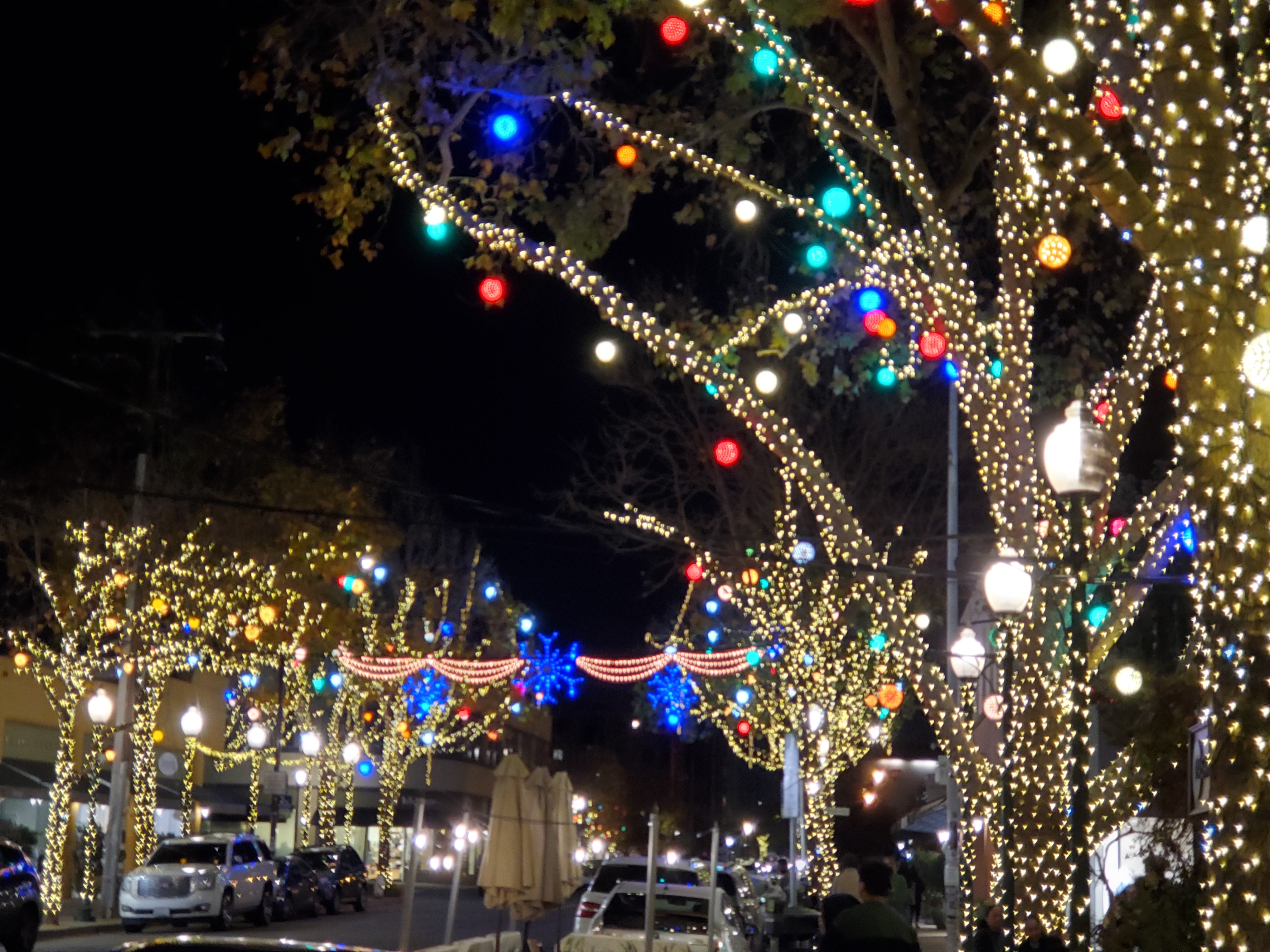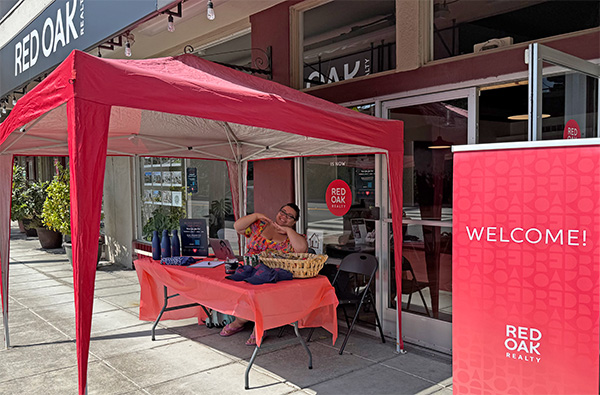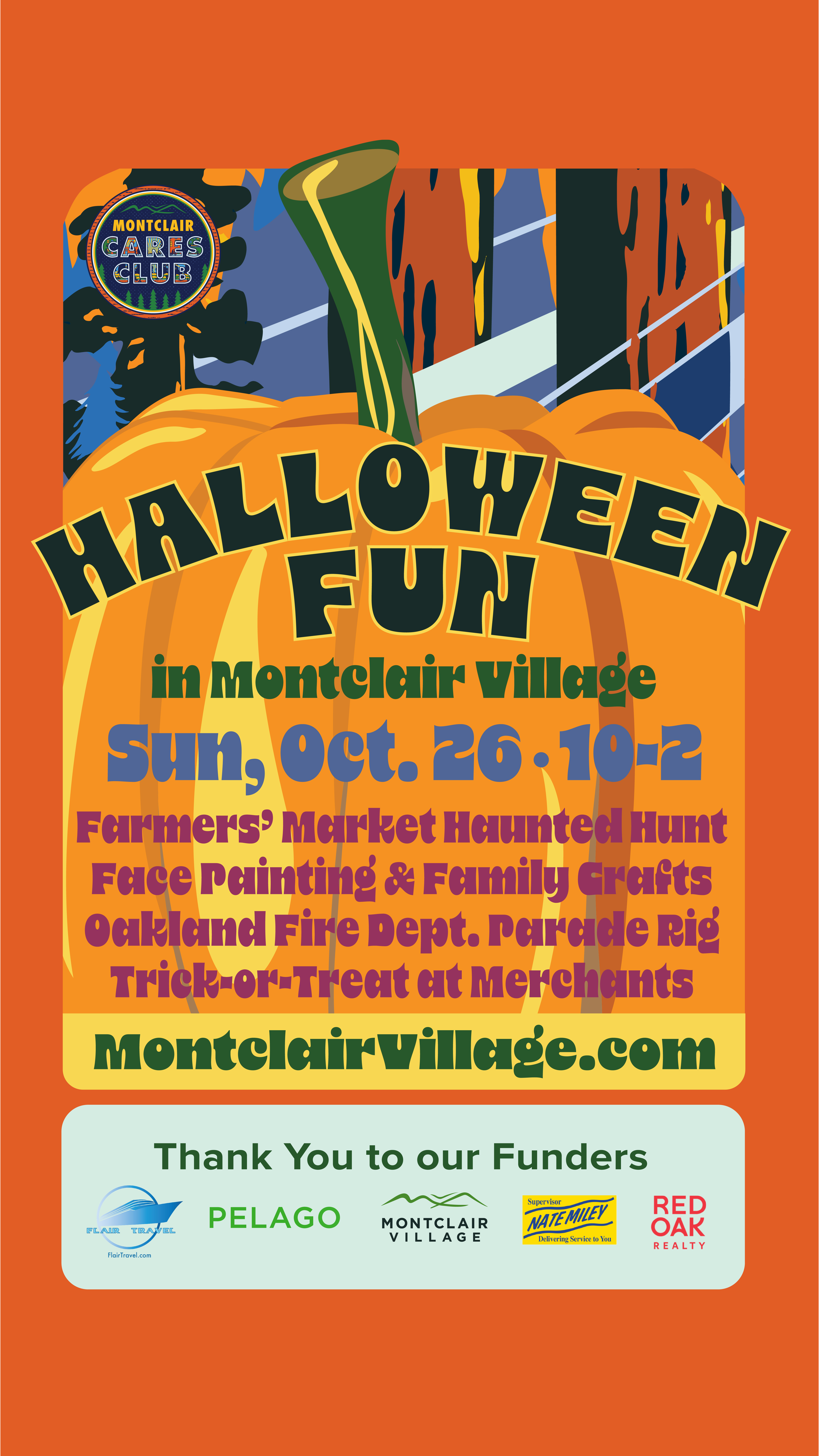Happy Thanksgiving!
This Thanksgiving, we want to take a moment to share our gratitude with you—our clients, colleagues, friends and family. Thank you for allowing us to be a part of your journey and trusting us with some of your most meaningful milestones.
We understand a home is more than a property. It’s where stories are written, memories are made, traditions take root and dreams take shape. Whether you’re buying, selling or simply reaching out for guidance, our connection with you goes far beyond business. It’s a relationship built on trust, care and a shared commitment to community.
From our family to yours, we wish you a warm and joyful Thanksgiving filled with love, connection and gratitude. Thank you for being such an important part of our story.

Holiday Events In The East Bay
This time of year brings out the joy and gratitude in everyone, regardless of religious beliefs, including many of our communities and local businesses joining in on holiday activities. Here are a handful of options to enjoy while celebrating the season with loved ones.
HOLIDAYS ON FOURTH STREET
Fourth Street Shops, Berkeley
Now until - February 2026 when lights will come down
Fourthstreet.com
OAKLAND ZOO GLOWFARI
9777 Golf Links Road, Oakland
Now until Jan 25, 4:30–9pm
Oaklandzoo.org
CHRISTMAS VILLAGE
3Crosses Church, 20600 John Drive, Castro Valley
Nov 28-Jan 11
3crosseschristmasvillage.com
HOLIDAY EVENTS
South Shore Center, Alameda
Nov 28-Dec 24
Alamedasouthshorecenter.com
CHRISTMAS TREE LANE
3200 Block of Thompson Ave, Alameda
Dec 3 - New Year's Eve
Facebook.com/christmastreelane
OAKLAND HOLIDAY TREE LIGHTING
Jack London Square, Oakland
Nov 29, 5:45–8pm
Visitoakland.com
WINTER WONDERLAND
Tilden Park, Berkeley
Dec 4 - Dec 21
Tildenmerrygoround.org
LIGHT UP THE SEASON
Hayward City Hall Rotunda & Plaza
Dec 6, 4–8pm
www.hayward-ca.gov/community-events/light-up-the-season
LIGHTED YACHTS & BOATS PARADE
Oakland/Alameda Waterfront
Dec 6 around 5:30
Lightedyachtparade.com
WINTER ON SOLANO AVENUE
Solano Ave, Albany/Berkeley
Dec 7, noon–5pm
Solanoavenueassn.org
HOLIDAY STROLL
Montclair Village, Oakland
Dec 11, 4–8pm
Montclairvillage.com
FAIRY WINTERLAND
699 Bellevue Ave, Oakland
DEC 13-14, 20-21, & 27-28, 12–7pm
Fairyland.org
SHADI HOLIDAY DISPLAY
7501 Moeser Lane in El Cerrito
Dec 13–26
Shadiholidaydisplay.com
Hope these help you make the most of the season. See you around the East Bay!


Give the gift of joy this holiday season
Every child deserves a little holiday magic - and you can help make that happen!
Red Oak has once again joined local businesses in the quest to make sure every child in the East Bay has a toy for Christmas. Since 1947, Toys for Tots has distributed 708 million toys to 314 million children.
Please consider donating a new, unwrapped toy to this worthy cause. Collection boxes are currently located at our Montclair, Berkeley, and El Cerrito Offices until December 10th.
- 1575 Hopkins Street, Berkeley
- 7502 Fairmount Avenue, El Cerrito
- 6450 Moraga Avenue, Oakland
Offices are open from 9:00am - 5:30pm, Monday-Friday. If you'd prefer to give a monetary donation, or a virtual toy, please click HERE to go to their website directly.
We hope you are inspired to give back, no matter the size of your donation.
Thanks For Helping Us Save Lives!
You're all lifesavers! A great big THANK YOU to everyone who donated at any of our three Red Oak blood drives. We are happy to report that we collected 41 units of blood, which means that over 115 people will be impacted by your generosity. Blood drives are critical for helping to save lives, which is why Red Oak will continue to organize and provide locations for these events.
Missed this last one? Our next blood drive will be announced early next year!



Micro-markets, Major Gains
FINDING VALUE IN THE BAY AREA – Q3 2025
The Inner East Bay real estate market in Q3 2025 marked a clear shift from the previous year, as rising inventory and tempered price growth gave buyers more leverage in certain neighborhoods and created a healthier balance between supply and demand. After several years of volatility and pricing climbs, prices stabilized – with the median single-family home price down 3.2% year-over-year – reflecting a continued correction from pandemic highs. Higher mortgage rates, hovering near 6.9%, led to more measured buyer activity and longer days on market, softening competition and prompting more strategic pricing among sellers. Still, with median home prices around $1 million – well below those in San Francisco, Marin, and the Peninsula – the Inner East Bay remained one of the Bay Area’s strongest values and most resilient housing markets.

Single-Family Home Performance by City
Oakland
Oakland’s market moved toward a possible opportunity for home buyers in Q3, with a median home price of $870,000, down 5% year-over-year. Active listings surged more than 30%, while closed sales dipped 6%. Average days on market rose to around 45, indicating longer sell times compared to pandemic-era lows.
Berkeley
Berkeley continues to dominate the East Bay for demand with its median home price reached$1.58 million, a 9% increase year-over-year, reflecting ongoing market strength. Both listings and closed sales rose, with most homes receiving multiple offers and selling within 23 days – a clear sign of sustained demand. On average, homes sold for 41% over list price, underscoring Berkeley’s enduring appeal among determined buyers.
Albany & El Cerrito
High-performing school districts kept Albany and El Cerrito in strong demand. Limited inventory meant homes that did list, sold quicker than other Bay Area neighborhoods – averaging 17 days in Albany and 21 days in El Cerrito. By contrast, Oakland and Richmond averaged 39-40 days on market.
El Cerrito’s median price climbed 27% year-over-year to $1.4 million, representing an 86% increase over the past decade. Both markets remain emblematic of the East Bay’s long-term investment potential.
Castro Valley & San Leandro
Castro Valley saw renewed energy in Q3, with a median sale price near $1.2 million (up 4% YOY) and a 50% increase in single-family home sales year-over-year, reaching 132 total transactions.
In contrast, San Leandro softened, with sales volume down 30% and prices mixed, reflecting cooler demand and slower turnover.
Piedmont
At the top of the market, Piedmont’s median home price neared $3 million, up 32% from 2024. Sales volume fell 25%, with only 15 homes sold in the quarter – consistent with a smaller, luxury-driven inventory pool. Low inventory and high demand are reflected in the high closed sales prices we have continuously seen in this sought-after neighborhood.

Neighborhood Highlights
Neighborhood-level trends in Q3 2025 reflected a mix of resilience and buyer opportunities, with some areas maintaining strong competition and others seeing modest price adjustments. If you’d like to see a third-quarter report on your neighborhood, reach out!

Condos
The condominium sector presented a particular opportunity: condo prices reached their lowest point in five years, offering attractive entry points for buyers despite their challenges with insurance, rising HOA fees and new point of sale requirements. Condo performance diverged notably from single-family homes in Q3 2025. Median prices for Inner East Bay condos dropped 25% from early 2022 peaks, reaching their lowest levels since 2016. For the first time in several years we saw buyers gaining more leverage thanks to rising inventory, though competition persisted for move-in ready or architecturally distinctive homes. With rising supply and more selective demand, buyers currently hold the advantage, particularly in Oakland and Emeryville, where competitively priced opportunities abound.

For Sellers
Even with moderating price growth, sellers retain strong equity positions, as most neighborhoods remain well above pre-pandemic levels. However, success requires realistic pricing and flexibility with an uptick in sellers reducing list prices by 4-7% compared to prior quarters to attract an offer. Premium neighborhoods still attract motivated buyers, but strategic pricing, professional presentation, and quick responsiveness prove essential. Well-prepared, fairly priced homes continue to sell – often within weeks. For those considering a sale in 2026, now is an ideal time to begin planning.
For Buyers
Buyers have the most favorable environment in years, particularly in the Oakland and condo market. With inventory at multi-year highs, slower price appreciation, and extended days on market, current conditions allow for greater negotiation and more careful decision-making. This isn’t the case as often with the Berkeley, Piedmont, El Cerrito and Albany markets. For those looking for an opportunity to get in a market where they may have been sidelined for years, there are creative lending programs and rate buydown options to help offset higher mortgage costs, making purchases more accessible. Today’s market offers a unique opportunity to find the right home at a fair price without the frenzied competition of previous years. Patience, preparation, and clarity about priorities are key to taking advantage of this balanced phase in the East Bay market.
The long-term forecast points to steady, sustainable appreciation, especially in markets tied to strong employment, excellent schools, and vibrant amenities. While buyers have regained some leverage since the pandemic boom, the East Bay remains the Bay Area’s best balance between affordability and lifestyle – and continues to stand out as a solid investment in an evolving market.
Whether you’re thinking about buying, selling, or simply keeping tabs on your home’s value, we can help you navigate the market with clarity and confidence. Reach out today to connect with a local expert and make the most of your real estate goals in the East Bay.
Red Oak Realty Sponsors Face Painting at Montclair Village Halloween Event
Red Oak Realty is excited to be part of Montclair Village’s annual Halloween festivities by sponsoring this year’s face painting booth. Families can enjoy a day full of Halloween fun, including trick-or-treating through the Farmers’ Market and Village shops, live music, craft stations, photo opportunities, and plenty of community activities.
Don’t miss this chance to celebrate the season with your neighbors! Come say hi to the Red Oak Realty team, enjoy the festivities, and make some magical Halloween memories.
Montclair Village Farmers' Market on Sunday, October 26th, 10 am to 2 pm.
Visit the website for more information

Buying a Home When Your Income Fluctuates
Why professionals with variable pay need a smarter plan
By Thuong Thien, CFP®, Principal & Senior Financial Advisor, Team Hewins
Featuring Vanessa Bergmark, CEO & Owner, Red Oak Realty
Bonuses, commissions, and stock options are common for many Bay Area professionals, but that income does not always come on a predictable monthly schedule. When you are thinking about buying a home, the ups and downs can feel overwhelming. How do you show a lender that your income is stable? How do you compete with buyers who have a steady salary?
The truth is, variable income doesn’t have to be an obstacle. With the right financial strategy and an agent who understands the local market, you can buy confidently and even turn your income structure into an advantage.
Here’s how to prepare.
Step 1: Understand Your Income Story
Your income has a rhythm. It might feel unpredictable, but there’s often more consistency than you realize. At Team Hewins, we help clients map out their cash flow, separating base salary from variable income and model how it plays out over time.
One client, a law partner, had uneven paychecks early in the year and large quarterly bonuses later. Once we mapped it, a pattern emerged and that clarity shaped a confident homebuying plan.
Step 2: Plan Months Before You Shop
“Most buyers start looking for homes before they’re financially ready,” says Vanessa Bergmark of Red Oak Realty. “In competitive markets like the Bay Area, you need your financing strategy in place months before making an offer.”
Sellers get offers from buyers who are pre-approved, pre-underwritten, or coming in with cash. Some buyers can even convert to financing after they purchase, letting them compete without loan contingencies.
"You could have a great price, but terms that drag things out 21 days on inspections, loans, or appraisals," Vanessa explains. "You might compete against someone with none of those hurdles. Sellers usually pick the path that closes faster."
This is why the months before house hunting matter more than the house hunting itself.
Step 3: Build a Bigger Cash Cushion
When your income fluctuates, keeping larger cash reserves can provide security and peace of mind. It’s about knowing you have a cushion to handle unexpected months without stress.
I notice there's often higher anxiety around cash flow with variable income. People naturally end up keeping more cash because they don't know what's coming next.
It's a smart concern. Together, we work through how much cash you actually need, ways to make that cash work harder while staying accessible, and how to structure your approach to support your long-term financial security.
The encouraging part? Your variable income pattern often creates opportunities, not just challenges.
Step 4: Work With Local Experts
Bay Area real estate isn’t like anywhere else. "We don't claim to know the entire United States," Vanessa says. "But we know exactly what we're doing” in the East Bay.
This local insight matters more than you might think. The way properties get priced in specific areas of the Bay differs completely from other markets. The marketing price isn't the transaction price. You need to understand the statistics, typical days on market, and how much properties usually go over asking.
"When you have almost 50 years of relationships and reputation, you just have very secure ongoing connections," Vanessa notes. "We know that territory very well, and our goal is to help position buyers to compete in that particular market."
It is about finding the right opportunity for your unique situation. Understanding the local market, including typical pricing, common offer terms, and how quickly homes sell, can make all the difference between landing your home and missing out.
Step 5: Connect the Whole Financial Picture
Your home isn’t just a transaction; it’s part of your overall financial life. When we model a home purchase together, we're modeling how it fits into your complete financial life. Tax implications, other cash flow needs, retirement planning, investment strategy, everything connects.
Our planning software helps us map your complete financial picture and shows you exactly what different scenarios look like. We can model selling your current house to buy another, or keeping both properties. We examine what happens under different income scenarios, inflation assumptions, and market conditions.
Working together through this visual approach, we help you discover possibilities you might not have considered and understand the real impact of different choices.
The Bottom Line
Variable income does not have to be a challenge. With the right preparation, what feels unpredictable can actually become an advantage, helping you make choices that support your life and your goals.
Homebuyers who plan carefully can find properties that fit their needs, compete successfully in competitive markets, and move forward with confidence. The key is avoiding the stress of stretching beyond what you can afford or missing opportunities by being too cautious. Your home should support the life you want, not create anxiety about money.
If you’d like guidance on how your income structure affects your homebuying options, Team Hewins offers a “Big Decision Clarity” meeting, designed to help you make confident financial moves that fit your real life.
Team Hewins, LLC (“Team Hewins”) is an SEC-registered investment adviser; however, such registration does not imply a certain level of skill or training, and no inference to the contrary should be made. We provide this information with the understanding that we are not engaged in rendering legal, accounting, or tax services. We recommend that all investors seek out the services of competent professionals in any of the aforementioned areas. Certain information provided herein is based on third-party sources, which information, although believed to be accurate, has not been independently verified by Team Hewins. Team Hewins assumes no liability for errors and omissions in the information contained herein.
October is Home Safety Month: Tips to Protect Your Home and Family
October isn’t just about pumpkins and cozy sweaters. It’s also Home Safety Month! At Red Oak Realty, we know that a safe home is a happy home. Whether you’re a new homeowner, thinking about selling, or just looking to make your current space safer, this is the perfect time to focus on home safety. With several earthquakes in the past couple of weeks, it’s especially important to think about earthquake preparedness along with everyday home safety.
Here are some practical tips:
1. Check Smoke and Carbon Monoxide Detectors
Your detectors could save lives. Make sure every level of your home has working smoke detectors and carbon monoxide detectors, and test them monthly. Replace batteries at least once a year.
2. Inspect Fire Extinguishers
Having a fire extinguisher in the kitchen and other key areas is crucial. Make sure it’s fully charged and everyone in your household knows how to use it.
3. Secure Doors, Windows, and Heavy Items
Locks aren’t just for front doors. Check that all windows and secondary entrances have sturdy locks. After recent earthquakes, also check that heavy furniture, TVs, and appliances are anchored to walls to prevent tipping.
4. Prevent Falls
Falls are one of the most common household accidents. Keep walkways clear, secure loose rugs, and ensure stairs have sturdy handrails. Night lights in hallways and bathrooms can prevent trips in the dark.
5. Winter Prep
With colder months approaching, inspect your heating system, chimney, and insulation. Make sure space heaters are used safely and never left unattended. Read more about our fall and winter home maintenance checklist by clicking here.
6. Outdoor Safety
Trim trees and bushes near walkways, check for loose railings, and ensure your outdoor lighting is sufficient. This not only prevents accidents but also deters potential intruders.
7. Earthquake Preparedness
Keep an emergency kit with water, food, flashlights, and first aid supplies. Identify safe spots in each room, like under sturdy tables or against interior walls. Practice “Drop, Cover, and Hold On” drills with your family so everyone knows what to do when the ground shakes. More details can be found here.
8. Emergency Planning
Create or update your family emergency plan. Know exit routes, designate meeting spots, and ensure everyone understands the plan. Keep emergency numbers handy.
A safe home is a smart investment and it protects the people who matter most. At Red Oak Realty, we’re committed to helping clients not just find a house, but create a home that supports their lives and goals. Taking small steps this October can make a big difference in safety and peace of mind.
If you’re buying, selling, or investing in real estate, we can guide you to homes with features that keep safety and comfort in mind. Reach out today to learn more about creating a safer home!
Fall Maintenance for Your East Bay Home
Autumn in the East Bay usually means crisp mornings, warm afternoons, and some of the most comfortable weather of the year. This season, we’ve already seen a few early showers, a helpful reminder that cooler, wetter months are right around the corner. Now is the time to get your home ready for shifting conditions and keep it running efficiently all season long.
Clean gutters, downspouts and roof scuppers: Clearing out leaves and debris from the roof’s drainage system prevents water from pooling and causing damage. Compost the organic waste to keep your cleanup eco-friendly.
Inspect the roof ridge and vents: Check for any damage or blockages in these areas. Repairing them early helps maintain your home's insulation, increasing efficiency.
Inspect siding, trim, soffits, and fascia boards: Look for holes or gaps and seal them. This not only prevents pests from entering, it also cuts your home’s energy use by reducing drafts.
Check windows and doors for proper sealing: Ensure that windows and doors are properly sealed to maintain indoor temperatures. Opt for weatherstripping made from recycled materials.
Clean up garden debris: Remove fallen leaves and branches to deter pests and insects. Use this organic matter to create mulch or compost, enriching your garden sustainably.
Check storm drains near the property: Report any blockages to your city to prevent flooding. Keeping storm drains clear helps local water systems function properly, benefiting the community and the environment.
Test the sump pump: Ensure your sump pump is working properly to prevent basement flooding. Regular maintenance extends its life and ensures efficient operation.
Inspect HVAC system and change air filters: A well-maintained HVAC system runs more efficiently, consuming less energy. Replace filters annually with high-efficiency options to improve indoor air quality.
Flush water heater: Removing sediment from your water heater improves its efficiency and longevity, saving energy and reducing your carbon footprint.
Test smoke and carbon monoxide detectors: Replace batteries and use the test button to confirm these essential devices are working properly.
Check fire extinguishers: The yellow tag attached to your fire extinguishers will tell you the last date of inspection. Make sure they are professionally checked annually and re-charged if needed.
Vacuum the vent hose and check for lint buildup in clothes dryer: Cleaning the dryer vent reduces fire risk and improves energy efficiency. While you’re in the laundry area, clean the washing machine filter too.
Schedule a chimney inspection: If you plan to use your fireplace, make sure it’s safe and efficient. A clean chimney burns more efficiently, reducing your home’s overall environmental impact.
Check for pests and look for possible entry points: Seal any gaps to keep pests out and maintain a comfortable, energy-efficient home. Use natural pest deterrents whenever possible.
Vacuum refrigerator coils: This task helps your refrigerator run more efficiently, conserving energy and extending its lifespan.
Set ceiling fans to rotate clockwise: This will move the warm air downward and keep the living areas more comfortable.
By staying ahead of maintenance now, you’ll keep your home safe, comfortable, and efficient throughout the cooler months. If you’d like help with any of these tasks, Red Oak has great resources and we’re happy to share. Just reach out.


